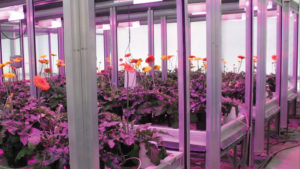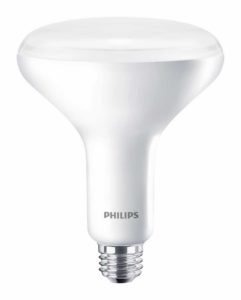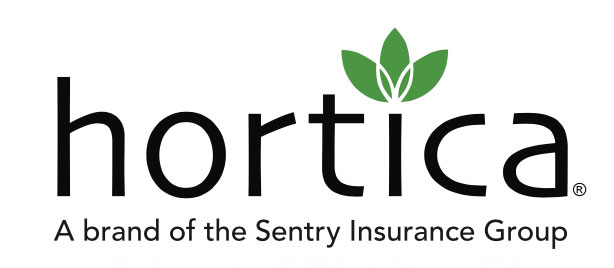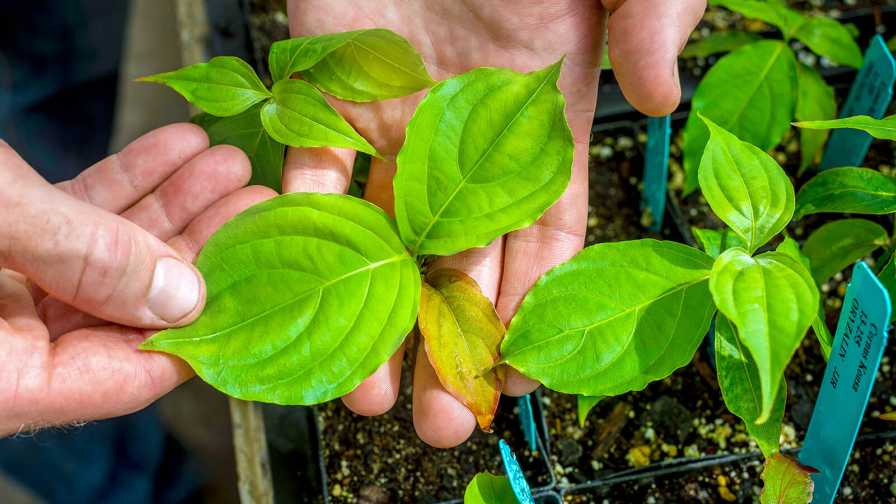How Lighting Companies Are Tackling Plant Quality
Innovative growers are always looking to keep up with the latest research in new technology, including lighting. Recently, three lighting suppliers were involved in projects — one at the research level and one at a commercial growing operation — that address how light affects plant quality. Here’s a look at the results of their efforts.

LumiGrow sought to determine the optimum light level for cut gerbera production during the 2015-2016 supplemental lighting season at higher latitudes.
New Scientific Posters from LumiGrow Research Show How Spectra Can Influence Plant Characteristics
LumiGrow Research, the research division of horticultural LED lighting manufacturer LumiGrow, Inc., has released a series of new scientific posters that show how light spectra can influence plant characteristics and commercial production.
According to the company, research conducted in partnership with commercial growers and universities demonstrates the breakthrough capabilities of adjustable-spectrum LED lighting.
Here are some of the key findings from the research, as well as links to the posters and the research team members.
Grafted tomato seedling propagation must be optimized to increase efficiencies. Grafting has several steps that include growing, grafting, healing, and acclimation. Healing, the joining of cambium between rootstock and scion to form vascular tissue, is considered the most important step and is commonly done under modified greenhouse conditions or inside healing chambers.
Previous work determined that light during the healing period influences morphology and quality of grafted tomatoes. Cool-white fluorescent (CWF) at a photosynthetic photon flux of 100 μmol·m-2·s-1 is recommended for healing chambers.
• Plant compactness and stem elongation normally achieved with plant growth regulators (PGRs) in mini-rose production can also be attained using light spectra. Low-blue light environments resulted in taller plants, while high-blue environments resulted in more compact plants in mini-rose trials.
Winter months in California have a Daily Light Integral (DLI) of 10 to 20, which is inadequate for optimal plant growth. To address this challenge, LED lamps are beginning to be used in preference over High Intensity Discharge (HID) lamps for their higher energy efficiency and longevity.
Making up a significant portion of the floriculture market, mini-roses typically require multiple applications of PGRs to prevent elongation, and achieve the targeted market height. PGRs also have been shown to present harmful environmental and health-related effects. It is hypothesized that applying a lower ratio of red:blue light to flowering mini-roses will achieve similar effects as PGRs, decreasing the total plant height without reducing flower count, production time, and quality.
This presentation included three experiments. The first experiment was done at Rocket Farms in Half Moon Bay, CA, in the greenhouse environment to examine the effect of both a High Red and High Blue LED light environment for a two- to three-week period at the end of the production season.
The second two experiments were done at LumiGrow’s research facility in Emeryville, CA, using a sole-source environment. In one case, the research team used LED alone at varying light ratios, but at the same intensity, to determine the response of the plants under all LED conditions. By contrast, in the other sole-source experiment, the team mimicked winter sunlight conditions to create “January in a Box,” by using a broad spectrum HID lamp and pairing it with a LED lamp of varying light ratios.
• A light level of 135 µmol•m-2•s-1 was determined optimal for growing cut gerbera from November through February at high altitudes using LumiGrow Pro 325 LED greenhouse fixtures. Accelerated flower development, hardier stems, increased chlorophyll content, and increased leaf count were all achieved with supplemental light for cut gerbera.
At higher latitudes, cut-flower growers rely on supplemental lighting for maximizing production in the darker months. Horticultural LEDs have been proven to produce similar or better crops (in terms of yield and quality) compared to HPS, while also having longer lifespans and higher energy efficiencies.
This project sought to determine the optimum light level for cut gerbera production during the 2015-2016 supplemental lighting season at higher latitudes.

NewLux developed a light plan for Greenbelt Microgreens that fit its physical environment and provided the intensity and uniformity the company required.
NewLux Works With Microgreens Grower on Uniform Light Distribution
According to Derek McLaughlin, Marketing Manager at NewLux Horticulture LED Lighting, growers today are looking for a reliable LED grow light that is going to provide the proper wavelength that their crops require, without producing large amounts of heat, while reducing energy costs.
NewLux has recently been working with Ian Adamson of Greenbelt Microgreens, which produces certified organic microgreens in Stouffville, ON, Canada. Adamson says that one of the biggest challenges for growers is that the market is being flooded with data by LED companies that can be confusing to growers. The volume of data and technology jargon makes it difficult for growers to make an informed purchase decision for their business.
Misadvertised technical specifications also seem to be an issue. Growers report overstated mols by some manufacturers, leading to poor crop growth. The proposed solution by these companies is for the grower to purchase additional fixtures to reach the required mols, which ends up costing the grower more than was originally quoted.
Finally, growers are worried about the cost of switching to the new technology. Most growers are concerned that the LED lighting technology is advancing so quickly that it may not be mature enough to warrant the switching cost at the present time. In a market that is so new, it is hard to determine which manufacturer is going to be the right choice for this large investment.
Greenbelt Microgreens had been looking for a lighting solution for its growing needs. Microgreens have an extremely short growing cycle and require accurate uniformity for harvesting. According to Adamson, most LED lighting on the market could not provide the operation with the light uniformity it was looking for.
NewLux developed a light plan that fit the physical environment for microgreens and provided the intensity and uniformity they required. With the many different lens shapes available on NewLux’s COB fixtures, the lights projected a uniform spread with no hotspots on the production area when fixtures were installed in a carefully thought out light plan.
The COB 350 and 700 Water-Cooled Greenhouse Light Fixture from NewLux features uniform spread. The water-cooling technology also allows growers to run the lights at a higher intensity and doubles the lifespan of the LED diodes, while eliminating the need for noisy cooling fans that are prone to failure. Because of the higher intensity output, fewer fixtures are required.
Moving forward, McLaughlin says NewLux has been expanding and adapting its wireless technology to provide growers with greater overall system controls and more real-time data. NewLux also has a new research center that is responsible for testing current models, as well as concept LED bars and fixtures.
“Our focus in the research center is optimal growth and better-tasting food, and we are constantly growing new crops and analyzing data to help our customers achieve the best results,” McLaughlin says.

The Philips GreenPower LED flowering lamp 2.0 provides an optimum spectrum and high light output and allows growers to save electricity costs by being 90% more energy efficient than conventional incandescent lamps.
Insights From Barbara Perzanowski, Marketing Communications Specialist at Philips Lighting
What are you hearing from your grower customers in terms of what they are looking for in greenhouse lighting today? What are the biggest needs they have, or the biggest challenges they are trying to address?
With lighting, consumers are aware of the energy savings that result from LEDs. Similarly, we find that growers are first and foremost interested in the energy savings.
A distant second would be spectrum. Few growers truly understand the importance of spectrum and how plants use blue and red. LEDs are the hot thing now, everyone is talking about them, and it is not surprising that growers are a bit overwhelmed and confused. This is why we collaborate with the grower. We learn of their challenges and their growing objectives and then develop a custom solution based on their needs.
Has there been a recent situation where you’ve worked with a greenhouse grower to help them address a problem?
Philips recently worked with a small tomato grower in Pennsylvania trying to grow tomatoes and lettuce in the winter. He knew he needed light but knew very little about LEDs. After a thorough analysis of his growing operations, we installed Philips LED toplighting and he’s seeing a significant increase in yield.
Battlefield Farms investigated using LEDs to help with a specific problem with their Heuchera tissue culture. After trying a couple different LED manufacturers and some different configurations, the grower was able to realize a higher transplant success rate with Philips LEDs.
We also worked with a tomato grower in Ontario, Canada, that was interested in extending his growing season through the winter. As a result of the greenhouse being a double-poly structure, the grower would not have been able to add high-pressure sodium lights because of the heat generated by the fixtures. With an installation of LED interlighting modules, the grower can deliver light to the crops while still managing the greenhouse climate.
What types of new products are you developing to address these needs?
The Philips GreenPower LED flowering lamp 2.0 is an even more energy efficient way to extend daylight or interrupt the night growing cycle in greenhouses for growers that cultivate strawberries, cut flowers, bedding plants, and cuttings. The new Philips GreenPower LED flowering lamp 2.0 builds on the first generation of Philips GreenPower LED flowering lamp and comes in two different spectral versions with light recipes for growing cut flowers and soft fruit. The new highly energy-efficient lamp is designed to increase the yield, quality, and consistency of crops and stimulate flowering. The first generation of the Philips GreenPower flowering lamp provided an important benchmark for energy efficiency following trials in 2014 and 2015 at the Research Centre Hoogstraten in Belgium, an independent horticultural research center. The next generation lamp provides an optimum spectrum and high light output and allows growers to save electricity costs by being 90% more energy efficient than conventional incandescent lamps. The lamps have a standard E27 or E26 fitting, allowing them to be used in existing installations, avoiding unnecessary modifications and reducing set-up costs.
Looking into the future, what do you have planned in terms of new lighting product development?
Philips is research/testing options for LED fixtures with a tunable spectrum or dimmable intensity.










